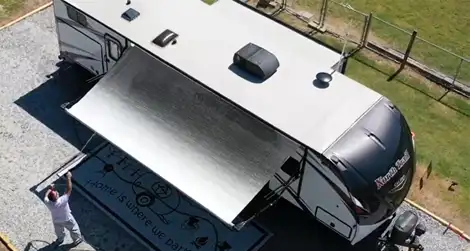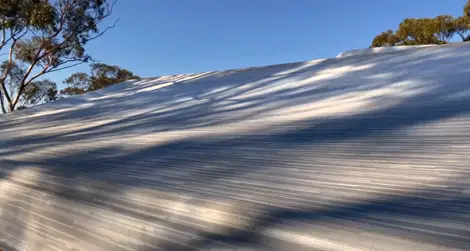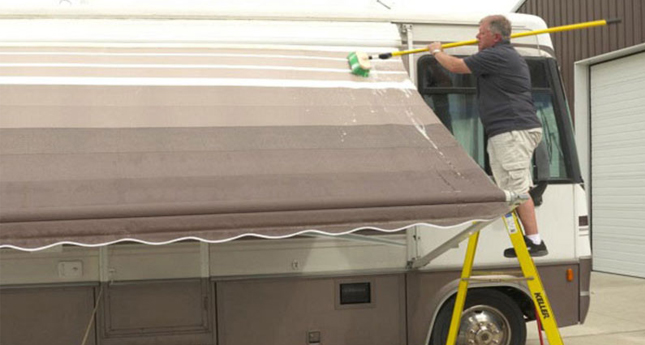Last Updated on April 13, 2023
RV camping is enjoyable, but when it’s time to set up camp and relax, you notice sap on the awning. Tree sap not only looks bad, but it can also be tough to eliminate. Without removing it, the awning can become discolored and eventually wear out the fabric.
A tree’s sap is produced separately from latex, resin, or cell sap, and is transported by xylem and phloem. Thus, it is mostly water with a few dissolved minerals and organic compounds. RV awnings get this when they come into contact with leaves or branches. So how to remove tree sap from camper awning without damaging it?
Let’s get started with our step-by-step guide for removing tree sap from camper awnings.
How to Remove Tree Sap from Camper Awning in Easy Steps?

RV awning care is important to keep your awning in good shape and prevent premature wear and tear. Not all tree sap is the same, but these steps will remove most types of tree sap.
Step 01: Check Awning Fabric
Before you begin removing tree sap from an RV awning, please remember to check the type of fabric your awning is made from. This will ensure you don’t damage the awning while trying to remove the sap.
Vinyl, acrylic, polyester vinyl composite, and metal are all durable materials that can withstand a little scrubbing. However, natural fabrics such as cotton or wool should be treated with care. These fabrics are more likely to be damaged by harsh chemicals or scrubbing.
Step 02: Inspect the Damage
Once you have determined which fabric it is made of, inspect the damage to determine how much tree sap there is and how difficult it will be to remove.
If the tree sap is fresh, it will be easier to remove than if it has been on the awning for a while. Fresh tree sap can usually be removed with a little soap and water. In case the sap is old and hardened, you may need to use a stronger cleaning solution.
Step 03: Choose a Cleaning Solution
There are many different cleaning solutions you can use to get tree sap off your RV awning. The best solution for you will depend on the type of material your awning is crafted from and the severity of the damage.
If you have a vinyl, acrylic, or polyester vinyl composite awning, you can use a mild soap and warm water solution. You may need to use a stronger RV awning cleaner if the tree sap is hard and old, such as vinegar, rubbing alcohol, WD-40, Goo Gone, or Simple Green.
Step 04: Apply the Cleaning Solution
Assuming you’ve already gathered your tree sap removal supplies, the next step is to apply the awning cleaner to the affected area of your RV awning.
Apply the RV cleaner to a clean rag and then rub it onto the tree sap stain, using circular motions. Be sure to avoid scrubbing too hard, as this could damage the surface of your awning. Continue until the tree sap stain is gone.
Step 05: Rinse Thoroughly
Once you have finished scrubbing the sap off of the RV awning, you should rinse the area thoroughly. You can use a garden hose or pressure washer for this step. Be sure to direct the water stream towards the ground, not up at the awning, in order to avoid damaging the material.
To ensure all of the cleaning solutions have been removed, you can also wipe down the area with a clean, damp rag.
Step 06: Check for Stains
Once you’ve removed as much of the sap as possible, it’s time to check for stubborn stains. If the sap stayed on the awning for an extended period of time, it may have caused some staining.
To test for stains, apply a small amount of the chosen cleaning solution to an inconspicuous area of the awning and wipe with a white rag. If the rag picks up any color from the awning, it is likely that there are stains that will need to be removed.
Step 07: Repeat as Needed
If tree sap is still present on your RV awning after following the above steps, simply repeat the process until the sap is removed. You may need to scrub a little harder to remove sap that has built up on the awning over a longer period of time.
In any case, be sure to rinse the area well after scrubbing to remove any soap residue. Again, avoid using harsh chemicals or abrasive materials that could damage your RV awning. When you have the proper supplies, the sap can be easily removed from your RV awning and keep it looking like new.
Step 08: Dry Awning Thoroughly
Once you have removed all the sap from your camper awning, make sure you dry the area thoroughly. This will help to prevent any mildew or mold from growing on the awning.
You can use a clean rag to wipe down the area and then let it air dry. When you need to speed up the process, you can use a hairdryer on low settingprocess. Just be sure not to hold the hair dryer in one spot for too long, or you might damage the awning material.
Step 09: Inspect and Repair Awning (Optional)
Once you have removed the tree sap and dried the awning, it is a good idea to inspect it for any damage. If the tree sap has caused any holes or tears in the awning, you will need to repair these before using the awning again.
Small holes can usually be repaired with a patch kit designed for the specific type of awning you have. For larger holes or tears, you may need to replace the affected section of the awning.
Now you know how to remove sap from RV awning. With these steps, you can keep your awning looking like new indefinitely. Just be sure to take safety precautions and avoid using sharp tools or abrasive chemicals.
How to Protect Your RV Awning from Tree Sap?

To prevent tree sap from damaging your RV awning, it is important to take some preventive measures.
1. Cover Your Awning: One of the best ways to protect your awning is to simply cover it when you are not using it. This will keep it from being exposed to the elements, including tree sap.
2. Choose Safe Parking Spots: When choosing a spot to park your RV, be sure to avoid areas with overhanging tree branches. If possible, park under trees that have been trimmed back so that the branches are not hanging over your RV.
3. Check for Sap Before Retracting Awning: Before retracting your awning, always check for sap and debris. The latter can cause damage to the awning material.
4. Clean Awning Regularly: Additionally, you should clean RV awning regularly, as you would any other piece of outdoor furniture. This will help to remove any build-up of sap or debris that could cause damage.
5. Inspect Awning Regularly: In addition to cleaning, you should also inspect your awning regularly for any signs of damage. If you notice unpleasant smells, rips, or holes, be sure to repair these as soon as possible.
By following these simple tips, you can keep your RV awning in good condition and avoid costly repairs.
Frequently Asked Questions
There are a few questions that are often asked about cleaning tree sap from RV awnings. Below are some of the most common questions and their answers.
1. How Do You Remove Tree Sap from a Camper?
Rubbing alcohol is a great choice, as it will help dissolve the sap and make it easier to remove.
Initially, make sure the sap is moistened with alcohol, then rub the rag over it. Then place the rag over the sap for a few minutes to let the alcohol soak in. Next, use a plastic scrubber or soft brush to scrub it. Finally, use dish soap and water, and then thoroughly rinse it.
2. What is Hardened Tree Sap Called?
It’s Amber. This sap is known as resin, and it is secreted by trees in order to heal wounds. Over time, this resin can form into amber, which is a beautiful and durable gemstone.
3. Is Tree Sap Poisonous to Humans?
The sap from trees may not be poisonous to humans, but it can be a nuisance. When the sap gets on your car or windows, you may find it very difficult to clean it off. The sap is sticky and smelly as well.
4. What’s the Difference between Sap and Resin?

Sap and resin are both natural products that help trees heal after being cut. The sap is a sugary liquid that helps to seal the wound and prevent infection. Resin is a sticky, thick liquid that also seals the wound and prevents infection.
Conclusion
Thank you for taking the time to read our tips on how to remove tree sap from a camper awning. We hope that you found this information helpful and that you will be able to remove the sap quickly and easily.
If you have any other tips or tricks that you would like to share, please leave us a comment below. We love hearing from our readers and we always appreciate your feedback. And, as always, happy camping.



